Seven Questions Over Breakfast with
James Ransome: Or, How Creating a
Picture Book is Like Making Banana Walnut Bread
 June 2nd, 2011 by jules
June 2nd, 2011 by jules
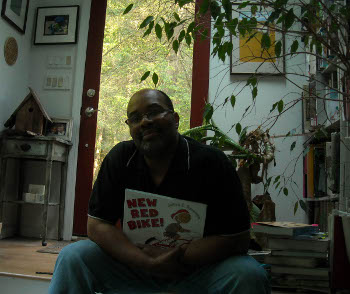 “Readers will likely marvel at why such a compelling figure has not received more attention,” writes Publishers Weekly about the subject of one of the latest illustrated titles from James E. Ransome, Before There Was Mozart: The Story of Joseph Boulogne, Chevalier de Saint-George (Schwartz & Wade, January 2011), written by Lisa Cline-Ransome (who happens to be James’s wife). This picture book biography tells the story of violinist Joseph Boulogne, the son of a white plantation owner and a black slave in the West Indies, born in 1745. Joseph eventually studied music in Paris, became a conductor and composer of his own operas (not to mention quartets, concertos, and ariettas), impressed Mozart himself, and played for King Louis the Sixteenth and Queen Marie Antoinette. (“Never before had a man of color entered the palace to perform for royalty!”)
“Readers will likely marvel at why such a compelling figure has not received more attention,” writes Publishers Weekly about the subject of one of the latest illustrated titles from James E. Ransome, Before There Was Mozart: The Story of Joseph Boulogne, Chevalier de Saint-George (Schwartz & Wade, January 2011), written by Lisa Cline-Ransome (who happens to be James’s wife). This picture book biography tells the story of violinist Joseph Boulogne, the son of a white plantation owner and a black slave in the West Indies, born in 1745. Joseph eventually studied music in Paris, became a conductor and composer of his own operas (not to mention quartets, concertos, and ariettas), impressed Mozart himself, and played for King Louis the Sixteenth and Queen Marie Antoinette. (“Never before had a man of color entered the palace to perform for royalty!”)
James, who is visiting me for breakfast this morning to discuss his books and art, rendered this story of an often-overlooked African American figure in rich and colorful mixed media illustrations, several of which are featured below.
to hear the orchestra perform.”
James’s very most recent picture book, released after Before There Was Mozart and which he both wrote and illustrated, is one I haven’t read yet, but he discusses that below. He’s had a busy 2011, making books, and it’s a pleasure to have him visit me for breakfast this morning; I’ve followed his work with interest over the past few years.
When asked about his meal-of-choice, I discover that I’m cyber-eating my cyber-breakfast with a fellow Southerner. “Being from the South,” he said, “my favorite breakfast would have to include grits, along with scrambled eggs. The choice of a side of meat is a toss-up between what my grandmother used to call ‘patty-cake sausage’ or bacon. And if it was my most favorite breakfast, there would have to be a biscuit on the side. I know: It’s really Southern, and now I mostly just have cereal with skim milk for breakfast.” {Note: James is pictured below with his grandmother.}
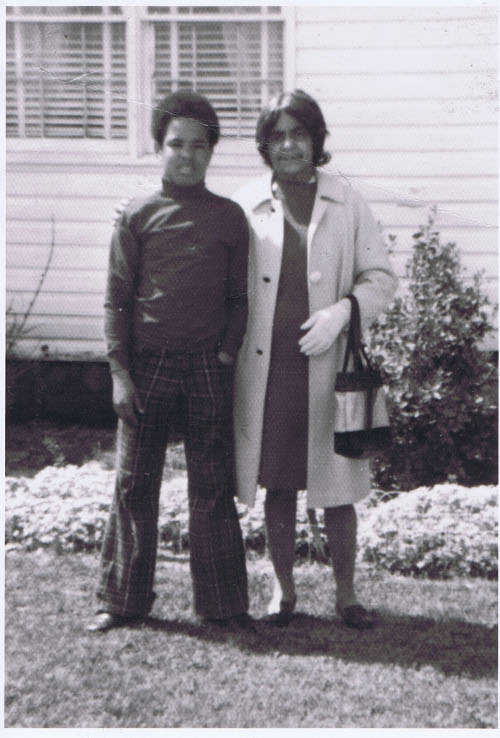
Well now. I was raised in Tennessee. I’m all about that heavy Southern breakfast. Let’s have at it, and I thank James for visiting today. Let’s get the basics, while we set the table for some good Southern biscuits . . .
Jules: Are you an illustrator or author/illustrator?
James: I’ve been illustrating books for 21 years and I’ve always considered myself an illustrator, although people would often refer to me as an author. Finally, this year (2011) I’ve had two books published, which I’ve both written and illustrated (Gunner came out in the Fall, and in March New Red Bike was released), so I’m happy to finally introduce myself as an Author/Illustrator.
Jules: Can you list your books-to-date?
James: About four years ago, my wife Lesa Cline-Ransome completed the manuscript for our most recent book: Before There Was Mozart, the story of an incredible musician, Joseph Boulogne, Le Chevalier de St. Georges, born to a slave mother and her master, who flourished as a classical violinist and composer, even performing for and giving lessons to Marie Antoinette. After the manuscript was finished, I began working on the book dummy. My wife and I went on research trips to Guadalupe, the island in the Caribbean where St. Georges was born, and the following year we went to Paris. I spent close to a year painting the images. This book is at the top of my list. As an artist, I was really attracted to the period clothing. I put a lot of time into getting it just right.
Anyone who spends time with me understands I’m a true football fan. The idea for the book Gunner came to me while doing school visits. I was shocked during a conversation with a group of elementary school students when I realized how important winning was to them. That’s what inspired me to write a book which deals with this topic: to try to give students some perspective, that there are different ways to win. It’s not always just the numbers on the scoreboard. For the illustrations, I reverted back to the way I used to work when I was in high school and influenced by the artists in Mad magazine: Mort Drucker and Jack Davis. I tried to show my sense of humor in my book, {Angela Johnson’s} The Girl Who Wore Snakes, but I think Gunner is the first true example of humorous illustrations.
The idea for my most recent book, New Red Bike, came from my desire to write something for very young children: pre-school and kindergarteners. I wanted to use the simplest to tell a story about sharing and the joy of riding a bicycle, an activity that I can’t find the time to enjoy as much as I’d like to.
Some of my all-time favorite books I’ve illustrated are:
- {Lesa Cline-Ransome’s} Satchel Paige
- {Margaret King Mitchell’s} Uncle Jed’s Barbershop
- {Deborah Hopkinson’s} Sky Boys

Jules: What is your usual medium, or––if you use a variety—your preferred one?
James: For years, probably close to 14 years, I worked exclusively in oils. Satchel Paige was my first book in acrylics. Then I finally became brave enough to do my first book in watercolors: {J.J. Reneaux’s} How Animals Saved the People.
I mostly now work in oil and acrylics together, but I have no favorites and I enjoy exploring all three of these media. Collage is the next on my list to try.
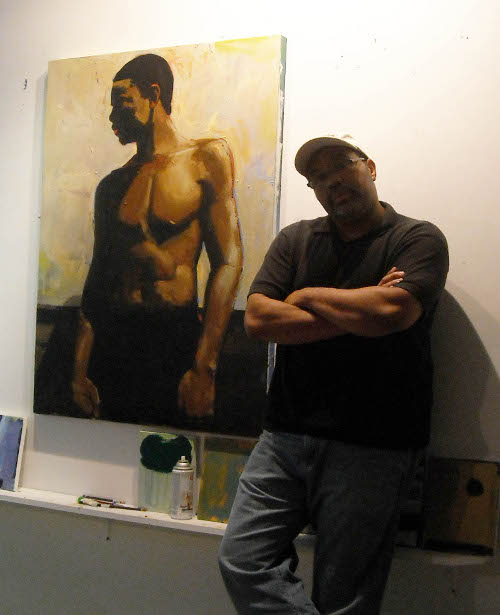
Jules: If you have illustrated for various age ranges (such as, both picture books and early reader books OR, say, picture books and chapter books), can you briefly discuss the differences, if any, in illustrating for one age group to another?
James: The books I’ve written are mostly for a younger audience. I just keep the shapes and the elements simpler. I find I really enjoy working for all ages. I’ve done chapter books, as well as picture books for an older audience — for example, {James Haskins’s and Kathleen Benson’s} Building a New Land and {Patricia and Frederick McKissack’s} Let My People Go.

Jules: Where are your stompin’ grounds?
James: Rhinebeck, New York, which is filled with writers and children’s book illustrators, painters, filmmakers, and artists of all types. For example, on a trip to the post office I might run into James Gurney, the author/illustrator of Dynatopia. My kids swim on the same team with Peter McCarty’s kids. He’s the author/illustrator of Hondo and Fabian. Author/illustrator G. Brian Karas’ son is in the same class as my daughter, so I see him often at school events.
the beating of drums and the strains of song…”
— From Lesa Cline-Ransome’s Before There Was Mozart: The Story of Joseph Boulogne, Chevalier de Saint-George (Schwartz & Wade, January 2011)
Jules: Can you briefly tell me about your road to publication?
James: I sent in a mailer with an example of my work to a publisher, who invited me to come in and show my portfolio. He offered me my first book contract, {Angela Johnson’s} Do Like Kyla.

Jules: Can you please point readers to your web site and/or blog?
James: www.jamesransome.com.
from which she had been stolen not so long ago.”
he still listened for the familiar beats echoing in the distance.”
— From Before There Was Mozart
Jules: I see you do school visits. Tell me what they’re like.
James: Fun. The highlight of my visit is when I invite kids up to write a number on a large pad, and then I turn that number into a character.
as they sailed across the wide Atlantic Ocean.”
— From Before There Was Mozart
Jules: If you teach illustration, by chance, tell me how that influences your work as an illustrator.
James: Influences come from a lot of sources. However, I am mostly influenced by artists like Degas and Mary Cassatt, who themselves were influenced by the composition, cropping, and flat shapes of Japanese artists. Most post impressionists and abstract expressionists are a great influence on my work.
The young man was Wolfgang Amadeus Mozart.”
— From Before There Was Mozart
Jules: Any new titles/projects you might be working on now that you can tell me about?
James: Right now, I’m working on a wonderful story by Jacqueline Woodson, entitled The Rope.

 Coffee and biscuits are on, and our table’s set now for our breakfast interview. Let’s get a bit more detailed, and I thank James again for stopping by.
Coffee and biscuits are on, and our table’s set now for our breakfast interview. Let’s get a bit more detailed, and I thank James again for stopping by.
1. Jules: What exactly is your process when you are illustrating a book? You can start wherever you’d like when answering: getting initial ideas, starting to illustrate, or even what it’s like under deadline, etc. Do you outline a great deal of the book before you illustrate or just let your muse lead you on and see where you end up?
James: I have a long process, so this is the edited-down, humorous version. However, I will say that I like to spend a lot of time with a book and let it marinate. That usually gives me the best results. My wife, author Lesa Cline-Ransome, is really interested in food, so a food reference is the best.

I like to equate my process with the making of banana walnut bread. The dummy is like gathering all the ingredients, sometimes going through three to four changes. (Trying to find bananas at just the right ripeness and walnuts takes time.) Then the models come in for a photo shoot, which is like carefully measuring all the ingredients. Drawing the images is like the process of mixing all the ingredients: a pinch of this a cup of that. Sometimes I find myself flipping things around, stirring up my ideas until they’re well-blended and the images come to life. Maybe I’ll decide to experiment on the composition, like adding pecans in addition to the walnuts. Once the bread mixture is ready, it’s placed in the oven — the painting process is the baking. This part of the creation process takes 3-4 months of intensive work. Then the warm bread is shipped off to the publisher, who then adds ice cream and other goodies and serves it to the waiting public.
2. Jules: Describe your studio or usual work space.
(Click to enlarge)
James: My studio is attached to my house. I spend a great deal of time there, so it has a couch and TV, as well as my computer, my easel, and a drafting table and light table. A set of bookcases lines one wall. A second wall has display brackets so that I can see the sequence of my paintings as I complete them. The third wall is completely blank for large works, and the last wall is all windows, looking out over my back yard which is mostly forested.
3. Jules: As a book lover, it interests me: What books or authors and/or illustrators influenced you as an early reader?
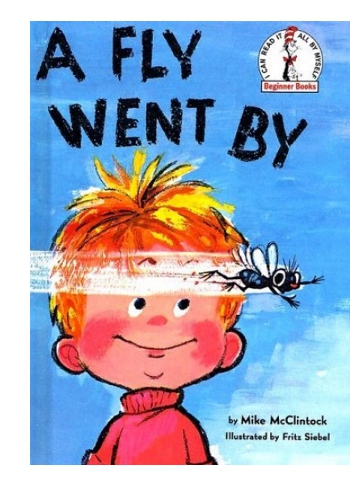 James: My all-time favorite book is from the Dr. Seuss series: A Fly Went By.
James: My all-time favorite book is from the Dr. Seuss series: A Fly Went By.
4. Jules: If you could have three (living) illustrators—whom you have not yet met—over for coffee or a glass of rich, red wine, whom would you choose?
James: I’m sorry, I know the rules are to list people I have not met. But I’d have to include someone whom I have met, who I think would be a wonderful guest to have at this type of event: Barry Moser. Toni Morrison, an adult writer who has also written some children’s books, and Richard Wright and George Orwell. Fortunately, I’ve met most of the children’s book authors and illustrators I admire.
5. Jules: What is currently in rotation on your iPod or loaded in your CD player? Do you listen to music while you create books?
James: I do listen to music while I work. 90% of the time, it’s a cable music station: Music Box Classical Jazz pumped through my stereo speakers. Another 5% I’m listening to something from my all-time favorite band from the ’70s and ’80s: George Clinton & Parliament Funkadelic. The final 5%, I’m listening to contemporary rappers, a young lady named Nicki and this little guy named Wayne are hot on my list.
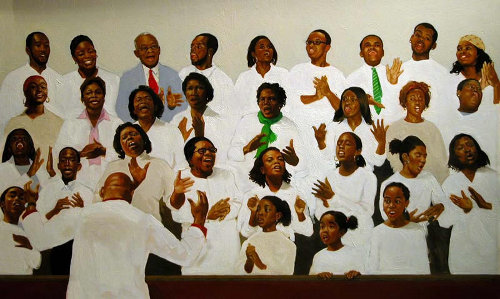
6. Jules: What’s one thing that most people don’t know about you?
James: That I’m really a loner.
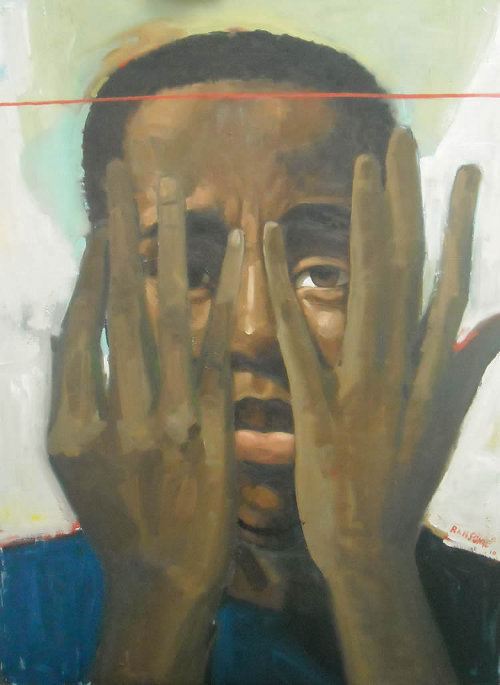
7. Jules: Is there something you wish interviewers would ask you — but never do? Feel free to ask and respond here.
James: “What is your favorite football team?”
The Miami Dolphins. (I know, that’s really off subject.)


Jules: What is your favorite word?
James: I don’t think I should say. I don’t think it would be appropriate for this audience.
Jules: What is your least favorite word?
James: I don’t really have one. I guess I should.
Jules: What turns you on creatively, spiritually or emotionally?
James: Having an idea, starting with a blank surface, and watching the idea develop.
Jules: What turns you off?
James: I can’t say—an editor may be reading this—but it has something to do with overzealous suggestions about ___________.
Jules: What sound or noise do you love?
James: Music, especially cow bells.
Jules: What sound or noise do you hate?
James: Breaks screeching.
Jules: What profession other than your own would you like to attempt?
James: So many. First, a defensive end position on the Miami Dolphins — but they could never trade me. A magician, play guitar with George Clinton & Parliament, real-estate tycoon.
Jules: What profession would you not like to do?
James: I wouldn’t like to be President of the U.S. Too much pressure.
Jules: If Heaven exists, what would you like to hear God say when you arrive at the Pearly Gates?
James: “You shouldn’t be here. We don’t have you scheduled for another ten years.”
All artwork and images used with permission of James Ransome. All rights reserved.
BEFORE THERE WAS MOZART: THE STORY OF JOSEPH BOULOGNE, CHEVALIER DE SAINT-GEORGE. Copyright © 2011 by Lesa Cline-Ransome. Illustrations copyright © 2011 by James E. Ransome. Reproduced by permission of the publisher, Schwartz & Wade, New York, NY.
The spiffy and slightly sinister gentleman introducing the Pivot Questionnaire is Alfred, © 2009 Matt Phelan. Thanks to Matt, Alfred now lives permanently at 7-Imp and is always waiting to throw the Pivot Questionnaire at folks.
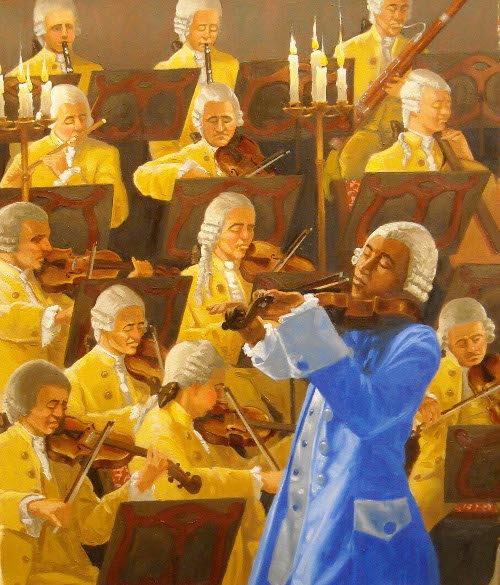
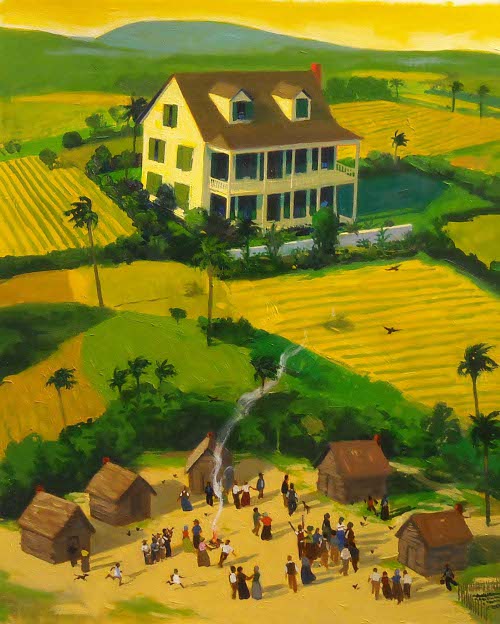
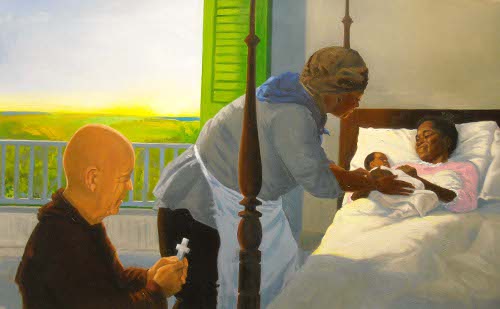
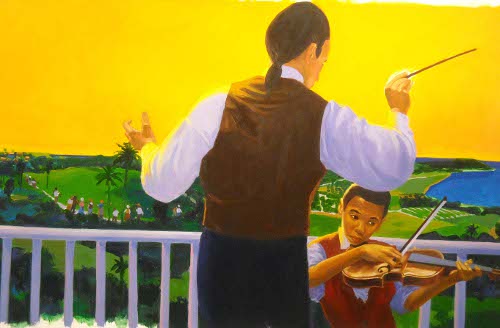



That Joseph Boulonge book is just beautiful — I can see the Degas and Mary Cassat influence in his artwork.
Also, I’m oddly hungry now for banana walnut bread… and grits…!
Great, great interview; male African American children’s book writers/illustrators are just not that thick on the ground, and it’s always nice to “meet” new ones.
I am going to hunt down every work I can find, that Before there was Mozart looks gorgeous! and maybe find some banana walnut bread to accompany my reads.
~L (omphaloskepsis)
I am so incorporating “patty-cake sausage” into my everyday conversation.
Coincidentally, I just had Do Like Kyla in my hands yesterday (found it for a patron who asked for it). James’ has illustrated a lot of books I admire, but I hadn’t really connected them before I read this interview. Thanks for that!
The shine and colors of those paintings. That studio. Cowbells. I’m a fan of Before There Was Mozart and look forward to New Red Bike!
Thanks, all.
Adrienne, I’ve enjoyed his illustration work for the past couple of years. (It was Young Pelé from ’07, written by his wife, that first caught my eye, and it was back then that I wanted to chat with him about his artwork, but I’m just reeeeeeally slow sometimes.) HOWEVER, it wasn’t till this interview that I also realized, like you, how many he’d illustrated prior to that, which I knew and had enjoyed — yet hadn’t made the connection.
Jeannine: YES. That shine.
Oh, and Tanita: I may not really be a True Southerner, though I was born and raised here, ’cause I’ve never liked grits. What’s up with that? Ah well. Can’t have ’em all.
But biscuits? Give me biscuits any day. (And biscuits while looking at James Ransome’s artwork are even better.)
Before There Was Mozart looks amazing…thanks for the tip!
I totally relate to the fact that you’re a loner. . . it’s a prerequisite to being an artist. Loners are good company!
Cute picture, too!!
One thing that didn’t come out in this is that James is an illustrator that truly likes writers and likes to collaborate with them on getting the details rights. He’s a very generous artist.
I just love how James can capture such beauty in each person he illustrates. How reallistic his illustrations are all is and I can really see each of the character’s true emotions!
You and Lesa are doing great work in the Art World, great interveiw.
I just love the pic. of you and Grand Mom
[…] many rejections, I sought advice from accomplished illustrators like Brian Pinkney, Floyd Cooper, James Ransome, Pat Cummings. Two years later, I had my first trade contract with Jump At The […]
AWESOME!
BEAUTIFUL AND AWESOME!
[…] Ransome’s Light in the Darkness: A Story About How Slaves Learned in Secret, illustrated by James E. Ransome (Disney/Jump at the Sun, […]
[…] From Jacqueline Woodson’s This Is the Rope: A Story fromthe Great Migration, illustrated by James Ransome(Click to […]
[…] Granddaddy’s Turn: A Journey to the Ballot Box (Candlewick, July 2015), illustrated by James E. Ransome, and Jonah Winter’s Lillian’s Right to Vote: A Celebration of the Voting Rights Act of […]
[…] Let’s get to it. I thank them for visiting. (Note: There’s also a sneak-peek below of new art from James E. Ransome.) […]
[…] Illustration by James Ransome: “Less sure than desperate, / I dip my spoon /into the bowl of years, / stir till I reach the […]